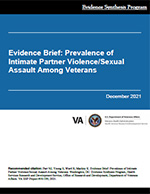
Prepared by:
Evidence Synthesis Program (ESP) Coordinating Center
Portland VA Health Care System
Portland, OR
Mark Helfand, MD, MPH, MS, Director
Recommended Citation:
Parr NJ, Young S, Ward R, Mackey K. Evidence Brief: Prevalence of Intimate Partner Violence/Sexual Assault Among Veterans. Washington, DC: Evidence Synthesis Program, Health Services Research and Development Service, Office of Research and Development, Department of Veterans Affairs. VA ESP Project #09-199; 2021.
Download PDF: Brief, Supplemental Materials
Moderate and low strength evidence suggests that psychological/emotional intimate partner violence is the most common form of experienced and perpetrated intimate partner violence/sexual assault (IPV/SA) among both Veteran women and men, followed by physical IPV and sexual IPV. Most available evidence pertains to experienced IPV/SA among Veteran women and perpetrated IPV/SA among Veteran men. Experienced IPV/SA among Veteran men, IPV/SA perpetrated by Veteran women, and IPV/SA among minority Veterans and intimate partners/spouses of Veterans are understudied.
IPV/SA includes physical violence, sexual violence including sexual assault, stalking, and psychological aggression by a current or former intimate partner ( ie , a spouse, dating partner, or sexual partner). The present review aimed to synthesize what is known about the prevalence of experienced IPV/SA (excluding non-partner SA) among Veterans and intimate partners of Veterans, as well as the prevalence of past-year IPV/SA perpetration by Veterans.
Considerable variation in sampling, recruitment, and data collection methods used among available studies limits the informativeness and quality of the overall body of evidence on IPV/SA among Veterans and spouses/intimate partners of Veterans. Moderate and low strength evidence suggests that psychological/emotional IPV is the most common form of experienced and perpetrated IPV/SA among both Veteran women and men, followed by physical IPV and sexual IPV. Most available evidence pertains to experienced IPV/SA among Veteran women and perpetrated IPV/SA among Veteran men. Experienced IPV/SA among Veteran men, IPV/SA perpetrated by Veteran women, and IPV/SA among minority Veterans and intimate partners/spouses of Veterans are understudied. Future studies of IPV/SA prevalence among Veterans should attempt to generate prevalence estimates that are applicable to Veterans of the range of ages, sexual and gender identities, races/ethnicities, and geographic contexts present in the Veteran population.
Evidence Brief: Prevalence of Intimate Partner Violence/Sexual Assault among Veterans (Management eBrief)